How to Teach Reading Strategies like a Boss by Implementing Tangible Takeaways
When you teach reading strategies, do your lessons ever feel like a one hit wonder? Perhaps your students practice a strategy in front of you with success, but then fail to apply it during independent reading. Maybe they forget the strategy the moment they leave your kidney-shaped table. It’s also not unusual for some students to have absolutely no recollection of what you taught them weeks or even days prior. Why? Somehow, we didn’t get the learning to STICK.
If any of this resonates with you, I have a helpful resource to help prepare you to teach reading strategies like a boss. My free Student Reading Strategies Personal Tracking Forms, along with this blog post, will leave you feeling equipped to move mountains with your students — and it’s all rooted in goal setting.
Goal-Setting Connects the Dots When It Comes to the Teaching of Reading Strategies
Prior to teaching our students anything, it is critical to have them set goals. It’s truly what gives learning purpose. Teaching reading strategies without being goal-oriented can feel like you’re teaching to a large crowd with the mic off. No one is able to take in what you have to say. You can share all the right information, but students may not be able to connect it to a higher purpose.
Where are my Tony Robbins fans?
“Setting goals is the first step in turning the invisible into the visible.”
Tony Robbins
When you think of it, visible = tangible. This holds true in the classroom, too. I’ll show you how implementing tangible takeaways will come into play for the teaching of reading strategies.
Goal Setting Jist: The When + The How
Setting goals can be done at the beginning of the school year, prior to starting a new reading unit, or anytime really. Goal setting for reading can be done whole-class, as students can personally reflect on themselves as readers. If you explicitly model how to choose a goal (and what a good goal may be), students may be equipped to choose their own goals.
Other times, you can provide an additional scaffold by conferring one-on-one with a student for a goal-setting conference. Here, you will guide students in seeing what they are already doing well as readers and what their next steps can/should be to grow.
Once (you and) the student decide on a goal, write it down.
I repeat: WRITE. IT. DOWN. Tan – gi – ble.
“It’s only a dream until you write it down, and then it becomes a goal.”
Emmitt Smith, former professional football player
Goals and Skills and Strategies – OH MY!
Before we delve into HOW to make learning stick, let’s be sure to precisely know what it is we’re talking about as we define some important terminology. In the field of education, it’s so easy to throw around words like reading goal, skill, strategy etc. However, believe it or not, these terms are not synonymous. If we consult our dear friend, Merriam-Webster, a goal is “the object of a person’s ambition or effort; an aim or desired result.” A skill is “a developed ability”. A strategy is defined as “a careful plan or method”. To put it plainly: strategies are what we use to practice a skill and work towards a goal.
Strategies are HOW We Reach Goals.
Let’s Get Personal
Allow me to paint a picture. Perhaps I want to set a personal goal of losing 5 pounds before summer begins. I don’t just say I want to lose weight; it’s 5 pounds exactly. Five pounds won’t stress me out with extreme yo-yo dieting or intense exercise my body can’t handle. I’m also giving myself a timeline, hoping to achieve this goal before summer begins. It’s precise and it’s possible.
In order to achieve this goal, I’m going to need to make a strategic plan. Writer and poet Antoine de Saint-Exupéry said, “A goal without a plan is just a wish.” I first think about the main two things that will influence this change: diet and exercise. We can think of these categories as skills: eating and working out.
(Thought Tangent: Somehow when I think of eating as a skill, my mind goes to my 7 year old self sticking penne pasta noodles on each of my fingers. Anyone else?)
Then, within these two skills, I brainstorm some specific things I may need to implement in my day-to-day life. The specificities are our strategies — ushering in a strategic action plan. Some of my strategies may be to drink more water (at least half my body weight in ounces), eat a nutrient dense salad for lunch each day, move my body with at least 30 minutes of yoga a few times a week, and avoid late-night snacking. Do you see how these specific strategies can help move the needle towards reaching my goal?
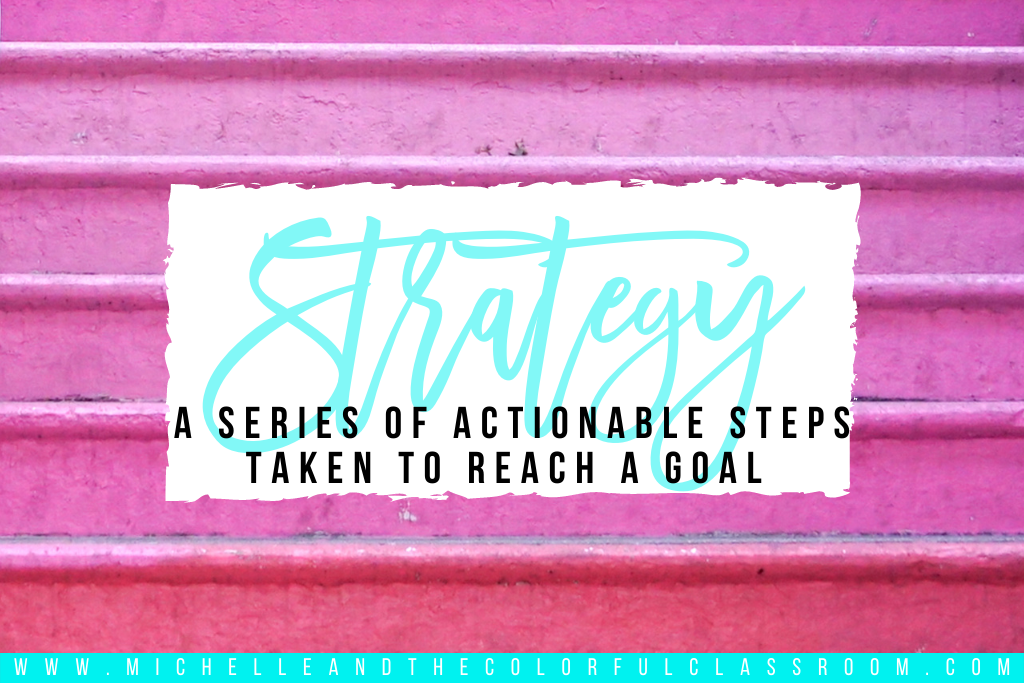
Let’s Talk Literacy
The same goes for the teaching of reading strategies!
When we think about teaching reading strategies, first and foremost, they need to fall under the umbrella of an overarching goal.
For example, if I am teaching reading comprehension strategies and my student’s reading goal is to be able to understand the plot of the story, I’m going to break it down into thinking: What types of skills support this comprehension work? A few skills that first come to mind are sequencing, summarizing, and inferencing.
Remember: THESE. ARE. NOT. STRATEGIES. Strategies are clear-cut. They provide the specificities, or actionable steps, for the readers to attempt/practice the skill — which will help them reach the goal.
Think about it: if you say to a student, “Make an inference.”, s/he may (or may not) look at you with a deer-in-headlights type stare, thinking, “…but HOW?”. It’s abstract. It’s just not tangible. However, since you’re a rockstar teacher, you dive into your toolkit and and pull out some strategies for teaching reading comprehension that breaks the skill “inferencing” into actionable steps. It might look like this:
- Use what you already know in your brain (about…such and such topic…)
- Think about the evidence you come across in the text: maybe it’s something you notice in the picture or something you read in the words
- Read between the lines (what the author DIDN’T tell you) to draw your OWN conclusion
(and then you may go on to model this in action)
THIS is a strategy. The skill (inferring) is the WHAT. The strategy is the HOW.
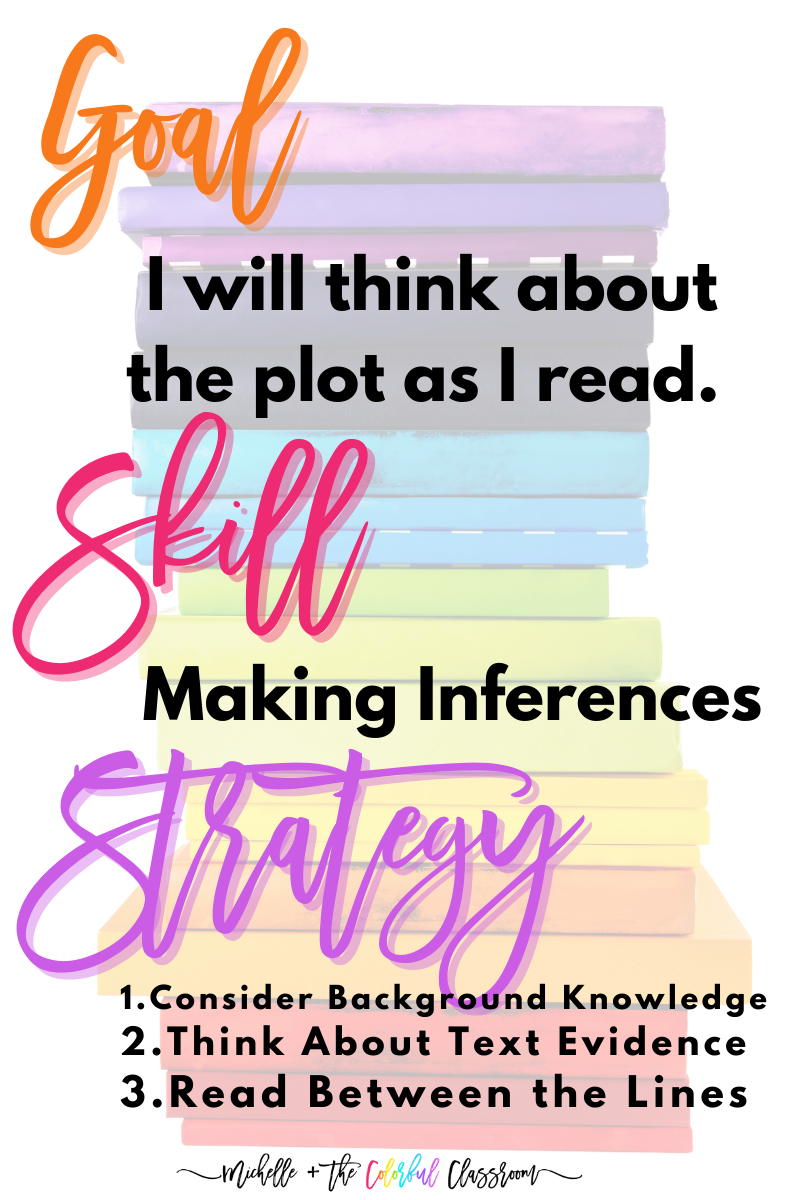
Learning Through the Senses Should Affect how we Teach Reading Strategies
How do we learn? That’s a loaded question, right? Neuroscience teaches us that we learn by absorbing information through our senses.
Think of babies. Did you know 90% of a child’s brain develops before kindergarten? (FirstThingsFirst.org) So if your typical 5 year old hasn’t experienced traditional school yet, what influenced all of this brain growth? Sensory experiences: mouthing different objects, touching different textures, seeing a vast array of colors, smelling distinct aromas, hearing various sounds & voices having authentic conversations — ultimately, experiencing the world. All of this is referred to as sensory input.
Why Learning Modalities are Important when Teaching Reading Strategies
When it comes to sensory input, we can also think of learning styles — as they’re truly focused on a few of our main senses.. seeing, hearing, and touching.
(While some people love the smell of library books, unfortunately smelling won’t quite make you a stronger reader. Eating books, won’t either.)
Visual, Auditory, Read/Write, and Kinesthetic Learners
You may remember writing extensively detailed lesson plans in college, differentiating for these different learning modalities, right? As busy teachers, we may not always deliberately write down every aspect of differentiation for every lesson in every single subject, every single day. However, a seasoned teacher incorporates these modalities naturally. It’s helpful to always consider these modalities in the back of your mind when you’re working through how to teach reading strategies.
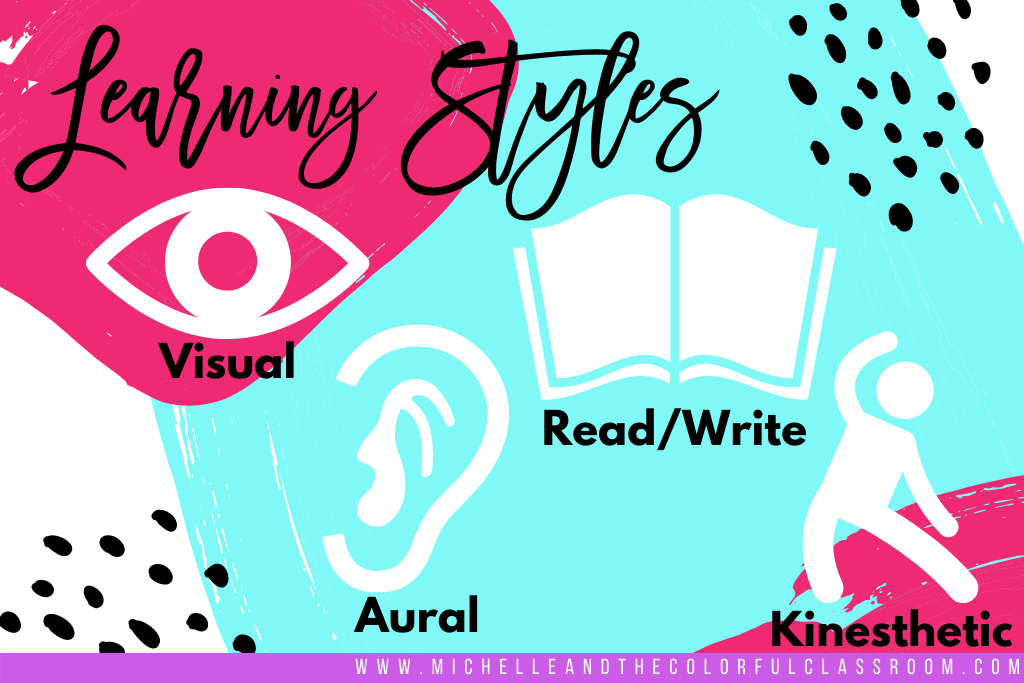
Aiming to teach with ALL four of these learning modalities will not only appeal to different types of learners, but also increase the amount of sensory input each learner is experiencing – which ultimately helps map information in the brain. Using the senses helps make the abstract tangible. This is the secret ingredient to helping learning stick.
Let’s break down how the teaching of reading strategies can look when we consider each learning preference.
Techniques for How to Teach Reading Strategies to VISUAL Learners:
- Use VISUALS, such as pictures, icons, and symbols
- Model strategies using picture books or video shorts
- Create mini-anchor charts (flowcharts, maps, diagrams) to outline actionable steps
- Consider print type and design elements: bold, UPPERCASE, underlining, italics, highlighting, and my favorite…dun, dun, dun: color coding
Techniques for How to Teach Reading Strategies AURAL Learners:
- Explain ideas and engage in conversations
- Allow students to repeat information they’ve heard
- Give students opportunities to think through actionable steps by talking aloud
- Give students opportunities to teach strategies (Note: This can be a solitary activity. A student can record herself working through or teaching a strategy on a platform like SeeSaw. This can also be a cooperative activity, where students can practice teaching one another. The emphasis is on having the opportunity to explain things aloud.)
Techniques for How to Teach Reading Strategies READ/WRITE Learners:
- Use lists — perhaps even bulleted lists or numbered lists
- Be purposeful with varied word choice
- Give students the opportunity utilize a dictionary or glossary to look up reading skills or other important terms
- Allow students to rewrite information in a way that makes sense. Perhaps they want to take notes or create their own lists after synthesizing your teaching.
Techniques for How to Teach Reading Strategies KINESTHETIC Learners:
- Try to make abstract skills and concepts more concrete by using real-life examples
- Incorporate gestures and body language to go along with a skill (Ex. Compare: hands clasped together // Contrast: hands far apart)
- Allow students to manipulate something tactile when working through a strategy (Ex. Moving hands down a “Retelling Rope”)
- Give students the opportunity to role play, or act out a strategy in a creative way
(Strategies Lifted from Vark-Learn)
Before you stick yourself (or your students) into a box, VARK-Learn Limited states that “Between 50-70% of any population seems to fit into [a multimodal] group”. That means the majority of people do not have just one style, or preference. They may have 2, or 3, or perhaps even a little bit of all 4. When I think of myself as a learner, the visual modality is certainly my strongest preference, followed by the read/write modality.
A Multisensory Approach for Making Reading Strategies Stick
Considering the majority of your students have multiple preferences when it comes to learning, you’ll want to get into the habit of infusing multiple modalities while you teach reading strategies, so it just becomes second nature. This way you can appeal to different types of learners and increase sensory input by using a multisensory approach.
“Whoa, whoa, whoa – multisensory?! But I’m not trained in that!”
Multisensory Misconceptions
When I think of multisensory learning, the first thing that comes to mind is special education, as these techniques are often used with learners who struggle. However, Amanda Morin of Understood.org states “All kids can benefit from multisensory lessons. If kids learn something using more than one sense, the information is more likely to stick. The result is better memory of the skill.”
The second thing that comes to mind is phonics instruction. If I close my eyes, I can envision little fingers tapping out phonemes before blending, writing letters in the sand, or even sky-writing words in the air.
Before you make yourself crazy thinking, “How on earth am I going to teach a child a prediction strategy using sand and play-doh?”, perhaps we need to define our terms again. What does it truly mean to utilize multisensory techniques? When we get down to the nitty gritty: a multisensory approach simply means using two or more senses at a time.
There are some keywords here: AT. THE. SAME. TIME. Simultaneously.
When we use more than one sense, it means we have more than one way to make connections, learn new concepts, and enhance memory.
The ultimate goal is to have students engage with material in more than one way. Seeing & hearing — hearing & touching — perhaps even incorporating visual, auditory, kinesthetic/tactile all in one.
So how can a multisensory approach be utilized alongside strategies for teaching reading comprehension?
My Very Good, Practical Tip, Friends! [for How to Teach Reading Strategies]
So, here is where Alexander and the Terrible, Horrible, No Good, Very Bad Day and “Please Excuse my Dear Aunt Sally” meet. We’ll be a little more positive than Alexander and ask Aunt Sally to kindly move over. If you truly want to know how to teach reading strategies like a boss, here is my mnemonic: My Very Good, Practical Tip, Friends! You’ll be teaching reading strategies with MVG-PTF in no time.
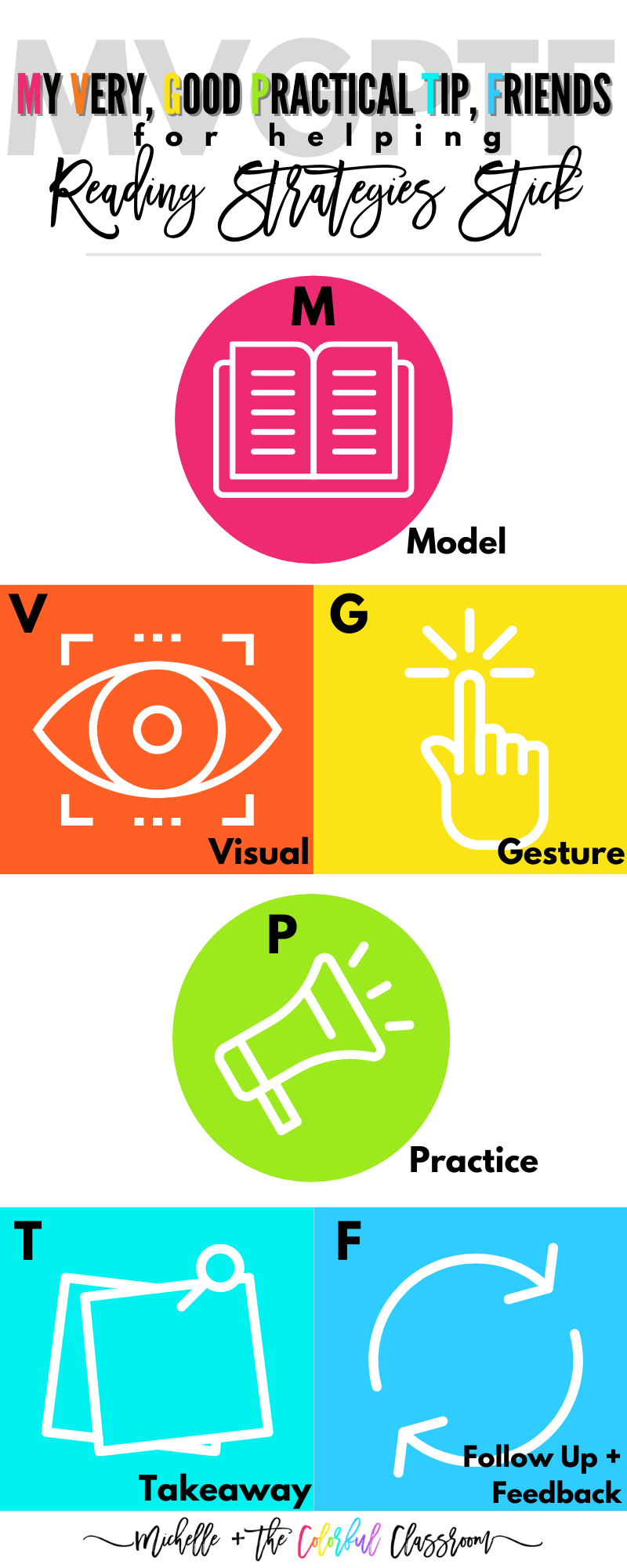
M is for Model
This is where direct instruction comes into play. The teacher will set students up for new learning, by connecting to their goal and introducing a new strategy.
Let’s plug in some ideas from our inferring strategy before.
Here’s some sample language. “You know how you’ve been working on understanding the plot of the story? I’ve gathered you together to teach you something new to support you in your goal. Today, I’m going to teach you… Watch me as I…”
V is for Visual
The teacher will represent the strategy using one/some technique(s) for how to reach reading strategies to VISUAL learners.
How? I might:
- Create a mini anchor chart with 3 icons: a brain, a book, and a magnifying glass
- Have each icon color-coded on different sticky notes
- Organize these sticky notes in a flow chart with arrows to show they are steps you take in a certain order
- Arrange this as a numbered list or pair words with the icons on my anchor chart (to appeal to the READ/WRITE learner)
G is for Gesture
The teacher will represent the strategy using one/some technique(s) for how to reach reading strategies to KINESTHETIC learners.
How? I might:
- Gesture tapping my head, tapping my book, and finally looking through imaginative glasses made with my hands as I model the strategy
- Have students tap on or trace along the actual brain, book, and magnifying glass icons on my mini anchor chart, as they recite each step.
Remember that the key to making gestures multisensory is pairing it with another sense simultaneously, so having them talk as they tap or maneuver their hands is essential.
P is for Practice
The teacher will represent the strategy using one/some technique(s) for how to reach reading strategies to AURAL learners.
How? Give students the opportunity to try this strategy right in front of you with their own book. As you coach in, each student will have the chance to articulate his/her thinking and work through the strategy by speaking and listening. You can also coach into partnerships rehearsing this work together. Teacher feedback here is essential for students to know if they’re on the right track.
T is for Takeaway
The teacher will EITHER personally represent the strategy on a sticky note (using one/some technique(s) for how to reach reading strategies to READ/WRITE and/or VISUAL learners) OR encourage students to have ownership of how the strategy is represented.
How? The objective is for students to receive a tangible takeaway on a sticky note. This tangible takeaway may be created by the teacher or student (Factor in age, ability, and pacing to determine what is most efficient for you. For example, if it’s going to take 5 minutes for a 7 year old to sketch a brain, it may be more practical for you to create the takeaway). This tangible takeaway will serve as a visual reminder for students to continually practice their reading strategies and to work on their goals. The takeaway can mimic your initial mini-anchor chart or accommodate your learners based on their learning preference.
(Want to bypass some sketching and planning time? Looking for strategies to teach reading comprehension used in these photos? Find them here: Printable Sticky Note Reading Strategies [Comprehension: Plot + Problems].)
F is (twofold) for Follow-Up + Feedback
Finally, the teacher will check-in on students at a later date to see how their strategy practice is going.
I wouldn’t let more than a week go by without checking in. Before even sending them off, let students know you’ll be following through. You may even choose to “book them” on the spot for another “appointment”.
The follow-up is important for a number of reasons:
- Keeps students accountable for practicing their strategies (they know you’re going to hold them to this work)
- Encourages students to ask for clarification if something didn’t make sense in the moment
- Keeps the teacher from having a “one hit wonder” small group by setting up a progression of future small groups and conferences
As we follow-up with students, we also want to assure we’re giving helpful feedback. Sometimes this serves as a compliment. Sometimes it serves as a teachable moment.
Consider the following – Is the student:
- Actually using the strategy?
- Practicing the strategy effectively?
- Utilizing the strategy regularly as they read?
OR
- Is this particular strategy not a good fit for this particular student?
- Does this student need reteaching? Additional practice? A new strategy?
The Endgame when Teaching Reading Strategies
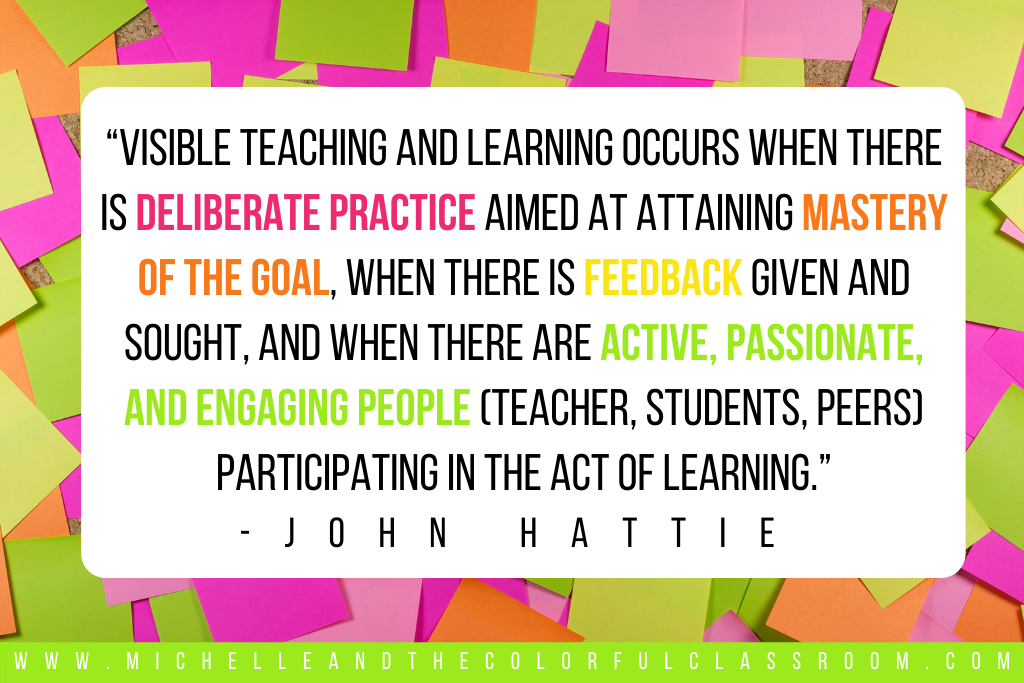
John Hattie’s research tells us:
“Visible teaching and learning occurs when there is deliberate practice aimed at attaining mastery of the goal, when there is feedback given and sought, and when there are active, passionate, and engaging people (teacher, students, peers) participating in the act of learning.”
Aiming to tinker in a multisensory approach within this deliberate practice is the icing on the cake. Having a tangible takeaway to reference is the sprinkles. EHEM, rainbow sprinkles.
Bringing Awareness to Strengths
As students take ownership of their goals and their learning with tangible takeaways, you may wonder what happens if they master a strategy?
It should be acknowledged, complimented and celebrated!
When we commend the things students are doing well, they are more apt to repeat these behaviors.
Do we throw these sticky notes in the garbage? No. We don’t want to symbolically throw the strategy in the garbage either.
If you already snagged my free Student Reading Strategies Personal Tracking Forms, you’ll notice there’s a page for students to keep track of the things they do well as readers. As the reading strategies transform from “in practice” to “in regular use”, students can confidently move them over to the next page. (Organizational tip: stick these tracking sheets back to back in a sheet protector. This way, no sticky notes will be lost in the learning of these skills!)
It can be a beautiful (and celebratory) thing to visually keep track of strengths in addition to strategies. Since much of what we do in reading is invisible, turning tangible takeaways into compliments can be a visual representation of progress and learning.
Final Thoughts: Teach Reading Strategies like a Boss
At the end of the day, fancy tools do not teach kids: good teachers do. Good teachers see their students strengths, styles & abilities, and help them level up.
Motivational speaker Greg Reid once said, “A dream written down with a date becomes a goal. A goal broken down into steps becomes a plan. A plan backed by action makes your dreams come true.”
Greg Reid, Motivational Speaker
Be the best teacher you can be by helping your students set goals, creating tailored plans for their success, and teaching meaningful strategies with multisensory experiences to help learning stick.
So, go ahead: teach reading strategies like a boss.
You know you want to.
…especially since now you know HOW to.
Related Articles
What is Multisensory Instruction?
A Framework for Student Goal Setting
Goal-Setting Practices that Support a Learning Culture
For more incredible ideas for engaging your students in upper elementary English Language Arts, check out these blog posts from some other great teacher bloggers:
How to Design a Research Project for Elementary
Why Upper Elementary Struggling Readers Need to Play Intervention Games
How to Easily Boost Comprehension and Empower Students Implementing Amazing Student Led Book Clubs
If you’re looking for tips on how to blog, check out: 7 Helpful Tips on How to Blog Like a Boss

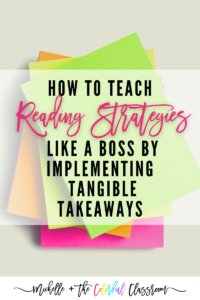
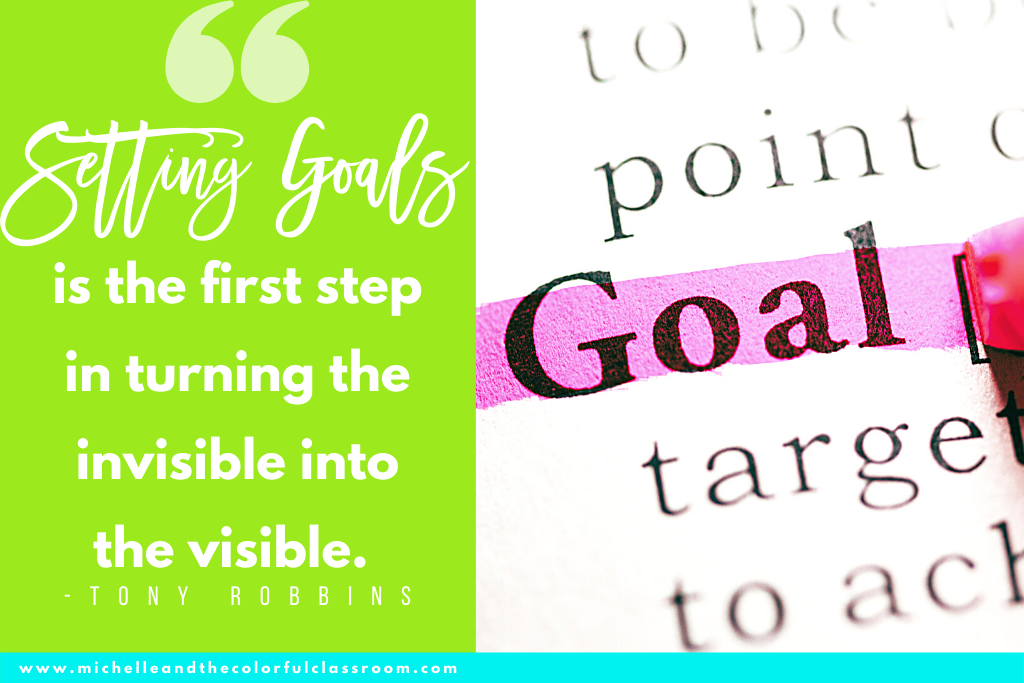
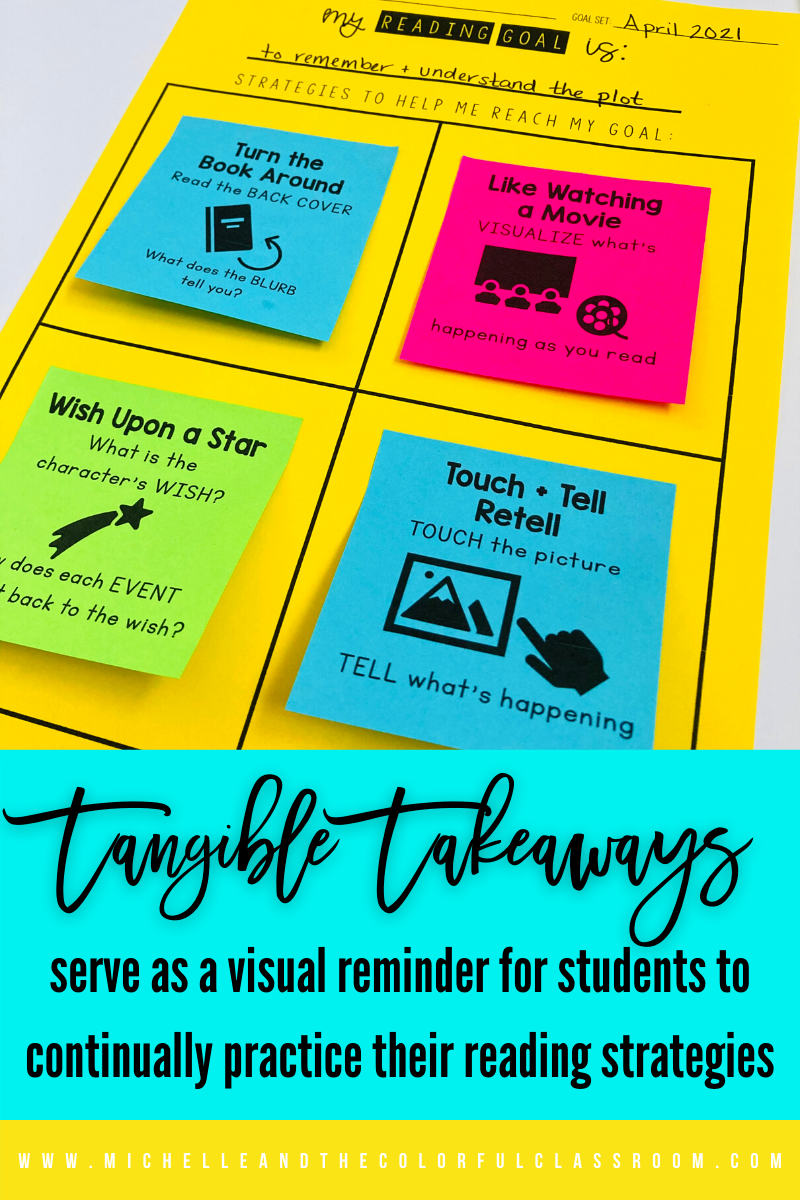
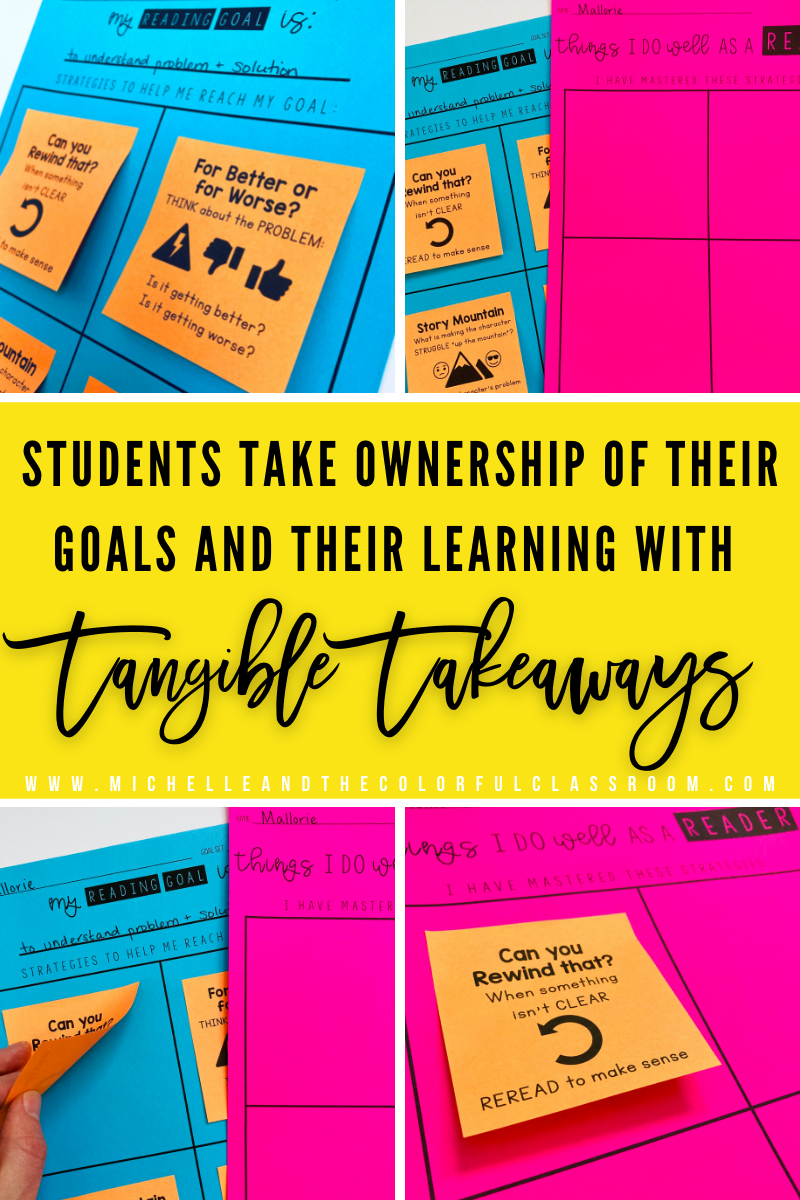
2 Comments